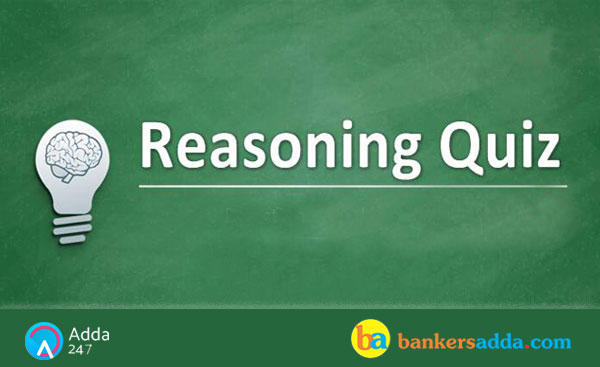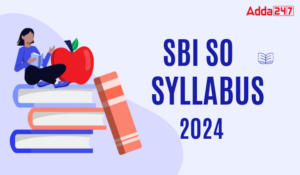Dear Aspirants,
Reasoning Questions for SBI PO Prelims 2018 (Week-06)
Reasoning Ability is an onerous section. With the increasing complexity of questions, it becomes hard for one to give it a cold shoulder. The only way to make the grade in this particular section in the forthcoming SBI PO Prelims and other banking exams is to practice continuously with all your heart and soul. And, to let you practice with the best of latest pattern questions, here is the Adda247 Reasoning Quiz with the exact same pattern of questions that are being asked in the exams.
Following the study plan for SBI PO Preliminary Examination 2018, the sixth week includes practice questions on Puzzles & Seating Arrangement, coding-decoding and Inequalities. To ensure proper preparation of the section we advise you to go through all the questions sincerely and try to attempt each one of them. Afterward, match your solutions and the approach with the one that would be provided later. Practice more and more questions on the same section to enhance your grip over the topics. Following is the Reasoning Ability quiz to help you practice with the best of latest pattern questions.
Direction (1-5): Read the following information carefully and answer the questions:
Eight persons A, B, C, D, E, F, G and H were born on the same day of the same month but in different years. All their ages are to be considered from the base year i.e. 2018. Each of them likes different colours- Pink, White, Blue, Brown, Yellow, Grey, Green and Orange. E is 9 years old and likes white colour. One of the persons was born in 1982. A was born in 1990 and 10 years older than C who likes blue colour. D is 6 years old and does not like pink and grey colour. Age difference between B and F who likes green is 13 years. H was born in 1985 and does not like Pink and yellow. G likes brown colour. The one who is 25 years old likes yellow colour. One of the persons was born in 2006.
Q1. What is the age of F?
(a) 9 years
(b) 18 years
(c) 12 years
(d) 15 years
(e) None of these
Q2. B was born in which of the following year?
(a) 2009
(b) 2000
(c) 1990
(d) 1993
(e) None of these
Q3. Who among the following was born in 2000?
(a) A
(b) B
(c) C
(d) H
(e) None of these
Q4. Which of the following combination is true regarding the given arrangement?
(a) G-36yrs-brown
(b) B-25yrs-yellow
(c) E-9yrs-white
(d) F-12yrs-green
(e) All are true
Q5. Who among the following likes orange colour?
(a) H
(b) A
(c) D
(d) E
(e) None of these
Directions (6-10): In the following questions, the symbols @, #, %, * and $ are used with the following meaning as illustrated below:
‘P @ Q’ means ‘P is not smaller than Q’.
‘P # Q’ means ‘P is not greater than Q’.
‘P % Q’ means ‘P is neither greater than nor equal to Q’.
‘P * Q’ means ‘P is neither smaller than nor greater than Q’.
‘P $ Q’ means ‘P is neither smaller than nor equal to Q’.
Now in each of the following questions assuming the given statements to be true, find which of the three conclusions I, II and III given below them is/are definitely true and give your answer accordingly.
Q6. Statements: M % R, R # T, T * N
Conclusions:
I. N * R
II. N $ R
III. N $ M
(a) All follow
(b) Only either I or II follows
(c) Only either I or II and III follows
(d) Only either I or III and II follows
(e) None of these
Q7. Statements: J #N, K @N, T $ K
Conclusions:
I. J % T
II. T $ N
III. N @ J
(a) None follows
(b) Only I and II follow
(c) Only I and III follow
(d) Only II and III follow
(e) All follow
Q8. Statements: B * D, D @ H, H % F
Conclusions:
I. B * F
II. B $ F
III. D $ F
(a) None follows
(b) Only either I or II follows
(c) Only either I or II and III follow
(d) Only III follows
(e) All follow
Q9. Statements: T $ K, K # R, R * M
Conclusions:
I. M * K
II. M % T
III. M $ K
(a) All follow
(b) Only either I or III follows
(c) Only either I or II follows
(d) Only either II or III follows
(e) None of these
Q10. Statements: V @ M, A $ M, R # V
Conclusions:
I. R # A
II. V @ A
III. R $ M
(a) Only I follows
(b) Only II follows
(c) Only III follows
(d) None follows
(e) All follow
Directions (11-15): In each of the questions below are given some statements followed by some conclusions. You have to take the given statements to be true even if they seem to be at variance with commonly known facts. Read all the conclusions and then decide which of the given conclusions logically follows from the given statements disregarding commonly known facts. Give answer
(a) if only conclusion I follows.
(b) if only conclusion II follows.
(c) if either conclusion I or II follows.
(d) if neither conclusion I nor II follows.
(e) if both conclusion I and II follow.
Q11. Statements:
a. All chimney are rays.
b. Some rays are cats.
c. All cats are tigers.
Conclusions:
I. Some tigers are rays.
II. Some tigers are chimney.
III. Some cats are chimney.
IV. Some rays are tigers.
(a) None follows
(b) Only I and II follow
(c) Only III and IV follow
(d) Only I and IV follow
(e) Only II and III follow
Q12. Statements:
a. All fans are rooms.
b. No room is green.
c. Some windows are green.
Conclusions:
I. Some windows are fans.
II. Some windows are rooms.
III. Some fans are green.
IV. No green is fan.
(a) Only I follows
(b) Only III follows
(c) Only IV follows
(d) Only II and IV follow
(e) All follow
Q13. Statements:
a. Some tablets are rains.
b. All dogs are rains.
c. All rains are chairs.
Conclusions:
I. Some chairs are tablets.
II. All dogs are chairs.
III. Some tablets are dogs.
IV. Some tablets are chairs.
(a) All follow
(b) Only I, II and III follow
(c) Only II, III and IV follow
(d) Only III and IV follow
(e) None of these
Q14. Statements:
a. No moon is sky.
b. No sky is road.
c. Some moon are roads.
Conclusions:
I. No road is moon.
II. No road is sky.
III. Some skies are moon.
IV. All roads are moon.
(a) None follows
(b) Only I follows
(c) Only I and III follow
(d) Only II and III follow
(e) None of these
Q15. Statements:
a. Some candles are houses.
b. Some houses are trains.
c. Some trains are roads.
Conclusions:
I. Some roads are candles.
II. Some trains are candles.
III. Some roads are houses.
IV. Some candles are roads.
(a) None follows
(b) All follow
(c) Only I and III follow
(d) Only II and III follow
(e) Only III and IV follow
Check Detailed Solutions Here
You may also like to read:





 The Hindu Review October 2022: Download ...
The Hindu Review October 2022: Download ...
 How to Prepare For General Awareness For...
How to Prepare For General Awareness For...
 SBI SO Syllabus 2024, Detailed Syllabus ...
SBI SO Syllabus 2024, Detailed Syllabus ...



